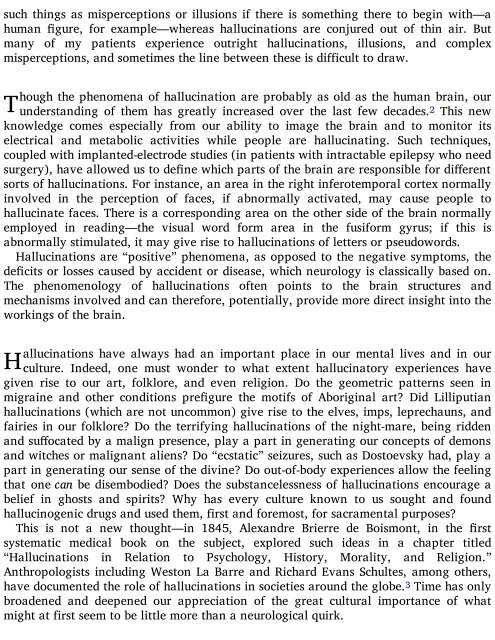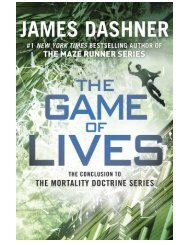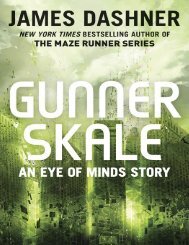32896589326509350
Create successful ePaper yourself
Turn your PDF publications into a flip-book with our unique Google optimized e-Paper software.
such things as misperceptions or illusions if there is something there to begin with—a<br />
human gure, for example—whereas hallucinations are conjured out of thin air. But<br />
many of my patients experience outright hallucinations, illusions, and complex<br />
misperceptions, and sometimes the line between these is difficult to draw.<br />
T<br />
hough the phenomena of hallucination are probably as old as the human brain, our<br />
understanding of them has greatly increased over the last few decades. 2 This new<br />
knowledge comes especially from our ability to image the brain and to monitor its<br />
electrical and metabolic activities while people are hallucinating. Such techniques,<br />
coupled with implanted-electrode studies (in patients with intractable epilepsy who need<br />
surgery), have allowed us to dene which parts of the brain are responsible for dierent<br />
sorts of hallucinations. For instance, an area in the right inferotemporal cortex normally<br />
involved in the perception of faces, if abnormally activated, may cause people to<br />
hallucinate faces. There is a corresponding area on the other side of the brain normally<br />
employed in reading—the visual word form area in the fusiform gyrus; if this is<br />
abnormally stimulated, it may give rise to hallucinations of letters or pseudowords.<br />
Hallucinations are “positive” phenomena, as opposed to the negative symptoms, the<br />
decits or losses caused by accident or disease, which neurology is classically based on.<br />
The phenomenology of hallucinations often points to the brain structures and<br />
mechanisms involved and can therefore, potentially, provide more direct insight into the<br />
workings of the brain.<br />
H<br />
allucinations have always had an important place in our mental lives and in our<br />
culture. Indeed, one must wonder to what extent hallucinatory experiences have<br />
given rise to our art, folklore, and even religion. Do the geometric patterns seen in<br />
migraine and other conditions pregure the motifs of Aboriginal art? Did Lilliputian<br />
hallucinations (which are not uncommon) give rise to the elves, imps, leprechauns, and<br />
fairies in our folklore? Do the terrifying hallucinations of the night-mare, being ridden<br />
and suocated by a malign presence, play a part in generating our concepts of demons<br />
and witches or malignant aliens? Do “ecstatic” seizures, such as Dostoevsky had, play a<br />
part in generating our sense of the divine? Do out-of-body experiences allow the feeling<br />
that one can be disembodied? Does the substancelessness of hallucinations encourage a<br />
belief in ghosts and spirits? Why has every culture known to us sought and found<br />
hallucinogenic drugs and used them, first and foremost, for sacramental purposes?<br />
This is not a new thought—in 1845, Alexandre Brierre de Boismont, in the rst<br />
systematic medical book on the subject, explored such ideas in a chapter titled<br />
“Hallucinations in Relation to Psychology, History, Morality, and Religion.”<br />
Anthropologists including Weston La Barre and Richard Evans Schultes, among others,<br />
have documented the role of hallucinations in societies around the globe. 3 Time has only<br />
broadened and deepened our appreciation of the great cultural importance of what<br />
might at first seem to be little more than a neurological quirk.

















